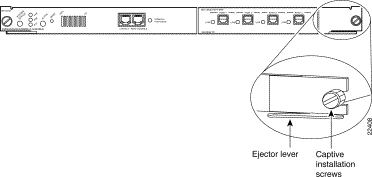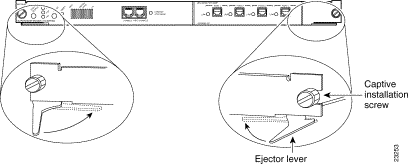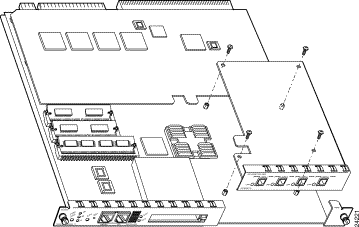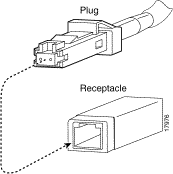|
|

Product Numbers:
WS-X5540(=) Supervisor Engine II G without Uplink Module
WS-U5534-GESX(=) Dual Port 1000BaseSX-MMF Uplink Module
WS-U5536-GELX(=) Dual Port 1000BaseLX/LH-MMF/SMF Uplink Module
WS-U5537-FETX(=) Four Port 10/100BaseTX Uplink Module
WS-U5538-FEFX-MMF(=) Four Port 100BaseFX-MMF Uplink Module
This installation and configuration note contains procedures for installing and verifying the operation of the Catalyst 5000 series Supervisor Engine II G.
This document contains the following sections:
Supervisor Engine II G includes the following features:
Supervisor Engine II G has the NFFC II chipset and modular uplink ports that can be configured with any of the supported uplink modules. Supervisor Engine II G is shown in Figure 1. See the "Supervisor Engine Uplink Modules" section for descriptions of the supported uplink modules.

Table 1 shows the supported uplink modules including product numbers and descriptions.
| Product Number | Description |
|---|---|
WS-U5534-GESX | Dual-port 1000BaseSX |
WS-U5536-GELX | Dual-port 1000BaseLX/LH |
WS-U5537-FETX | Four-port 10/100BaseTX |
WS-U5538-FEFX-MMF | Four-port 100BaseFX |
The uplink module faceplates are displayed in Figure 2 through Figure 5.




This section describes the front panel features of the Supervisor Engine II G. (See Figure 6.)

The LEDs on the supervisor engine front panel indicate the status of the system, which includes the states of the supervisor engine, the power supplies, and the fan assembly. Table 1 describes the LEDs.
| LED | State | Description |
|---|---|---|
| Indicates the status of switch based on a series of self-tests and | |
| Green | All the tests pass. |
| Red | Any test fails. |
| Red | During system boot or if the module is disabled. |
| Orange | The redundant power supply is installed but not turned on or receiving input. |
| Orange | The fan module fails. |
| Indicates the status of whether or not the fan is operational. | |
| Green | The fan is operational. |
| Red | The fan is not operational. |
| Indicates the status of the power supply in the left bay. | |
| Catalyst 5000, Catalyst 5505, Catalyst 5509, and Catalyst 5500 switches: | |
| Green | The power supply in the left bay is operational. |
| Red | The power supply in the left bay is not operational, switched off, or not receiving input power. |
| Off | The power supply in the left bay is off or not installed. Note The Catalyst 5500 power supply LED is red when no modules are installed. |
| Catalyst 5002 switch: | |
| Green | The power supply associated with the PS1 AC receptacle or DC terminal block is operational. |
| Red | The power supply associated with the PS1 AC receptacle or DC terminal block is not receiving input power. |
| Indicates the status of the power supply in the right bay. | |
| Catalyst 5000, Catalyst 5505, Catalyst 5509, and Catalyst 5500 switches: | |
| Green | The power supply in the right bay is operational. |
| Red | The power supply in the right bay is not operational, switched off, or not receiving input power. |
| Off | The power supply in the right bay is off or not installed. Note The Catalyst 5500 power supply LED is red when no modules are installed. |
| Catalyst 5002 switch: | |
| Green | The power supply associated with the PS2 AC receptacle or DC terminal block is operational. |
| Red | The power supply associated with the PS2 AC receptacle or DC terminal block is not receiving input power. |
1-100% | If the switch is operational, the switch load display indicates (as an approximate percentage) the current traffic load over the backplane (see Figure 7). | |
Green | The supervisor engine is operational and active. | |
| Orange | The supervisor engine module is in standby mode. |
Green | The port is operating at 100 Mbps. | |
1000 Mbps | Green | The port is operating at 1000 Mbps. |
Green | The port is operational. | |
| Orange | The link has been disabled by software. |
| Flashing Orange | The link is bad and has been disabled due to a hardware failure. |
| Off | No signal is detected. |
The Reset button allows you to restart the switch.
The Switch Load display provides you with a visual approximation of the current traffic load across the backplane. The Supervisor Engine II G Switch Load display indicates the current aggregate traffic load across all buses. Figure 7 shows the appearance of the Switch Load display.

The console port allows you to perform the following functions:
The RSFC console port enables you to configure the switch for multiprotocol routing using Cisco IOS software.
The console port and RSFC console port are EIA/TIA-232 asynchronous, serial, full-featured data terminal equipment (DTE) connections with hardware flow control and RJ-45 connectors. A console port accessory kit with the necessary cabling and adapters is provided for making your terminal connection.
The console port mode switch allows you to connect a terminal to the supervisor engine using the desired console cable.
You also can connect a modem to the console port using the cable and adapter provided with
the switch.
Use the console port mode switch as follows:
For more information on using the console port, refer to the Catalyst 5000 Series Supervisor Engine Installation Guide.
Onboard memory consists of dynamic random-access memory (DRAM) for the default system software, Flash memory for downloading and storage of the system software, and nonvolatile RAM (NVRAM) for the configuration file. Refer to the release notes for your Catalyst 5000 series supervisor engine software release for the minimum requirements.
Flash memory allows you to load and store system software images. Supervisor Engine II G has 8 MB of Flash memory. You can download a new software image over the network or from a local Trivial File Transfer Protocol (TFTP) server.
An electronically erasable programmable ROM (EEPROM) component on the supervisor engine stores module-specific information, such as the module serial number, part number, controller type, hardware revision, configuration information, and other details unique to each module. The supervisor engine EEPROM also contains an address allocator, which is a bank of 1024 hardware or media access control (MAC)-level addresses, one for each possible VLAN in the system.
The configuration file is stored in nonvolatile random-access memory (NVRAM).
Safety warnings appear throughout this note in procedures that, if performed incorrectly, may harm you. A warning symbol precedes each warning statement.
 | Warning This warning symbol means danger. You are in a situation that could cause bodily injury. Before you work on any equipment, be aware of the hazards involved with electrical circuitry and be familiar with standard practices for preventing accidents. To see translations of the warnings that appear in this publication, refer to the appendix "Translated Safety Warnings" in the Catalyst 5000 Series Supervisor Engine Installation Guide. |
This section covers the following topics:
Use the following guidelines to ensure your safety and protect the equipment. This list does not include all potentially hazardous situations during installation, so be alert.
 | Warning Only trained and qualified personnel should install, replace, or service this equipment. |
 | Warning Before working on equipment that is connected to power lines, remove jewelry (including rings, necklaces, and watches). Metal objects will heat up when connected to power and ground and can cause serious burns or weld the metal object to the terminals. |
 | Warning Ultimate disposal of this product should be handled according to all national laws and regulations. |
When working with electrical equipment, exercise these basic safety guidelines:
 | Warning Do not work on the system or connect or disconnect cables during periods of lightning activity. |
ESD damage occurs when electronic modules or components are improperly handled and can result in complete or intermittent failures. To prevent ESD damage, follow these guidelines:
 | Caution Periodically check the resistance value of the antistatic strap. The measurement should be between 1 and 10 megohms (Mohms). |
The ejector levers on the supervisor engine align and seat the supervisor engine connectors in the backplane. See Figure 8. If you fail to use the ejector levers to insert the supervisor engine, you can disrupt the order in which the pins make contact with the backplane. When removing a supervisor engine, use the ejector levers to ensure that the supervisor engine connector pins disconnect from the backplane properly. Any supervisor engine that is only partially connected to the backplane can disrupt the system.

Before you remove the supervisor engine from the switch, you should first upload the current configuration to a server. This saves time when bringing the supervisor engine back online. Enter the write network command to upload the configuration file to the network. Enter the copy command to download the current configuration to a Flash memory device on the new supervisor engine.
To remove the supervisor engine from the switch, follow these steps:
 | Caution To prevent ESD damage, handle switching modules by the carrier edges only. |
 | Caution When removing or inserting a switching module, always wear an ESD wrist strap connected to the Catalyst 5000 series switch ESD wrist strap connector. |
Step 1 Take the necessary precautions to prevent ESD damage, as described in the "Preventing ESD Damage" section.
Step 2 If you do not plan to immediately reinstall the supervisor engine you are removing, disconnect any network interface cables attached to the uplink ports.
Step 3 Use a screwdriver to loosen the captive installation screws at the left and right sides of the supervisor engine.
Step 4 Grasp the left and right ejector levers. Simultaneously pull the left lever to the left and the right lever to the right to release the supervisor engine from the backplane connector.
Step 5 Grasp the supervisor engine with one hand and place your other hand under the carrier to support and guide the supervisor engine out of the slot. Avoid touching any of the components on the supervisor engine.
Step 6 Carefully pull the supervisor engine straight out of the slot, keeping your other hand under the carrier to guide it. Keep the supervisor engine horizontal to the backplane.
Step 7 Place the removed supervisor engine on an antistatic mat, foam, or bag.
 | Caution Always install a switching module filler plate in empty switching module slots to maintain the proper flow of cooling air across the modules. |
When installing the supervisor engine, note that it must go in a specific slot:
To install the supervisor engine, follow these steps:
 | Caution To prevent ESD damage, handle switching modules by the carrier edges only. |
 | Caution When removing or inserting a switching module, always wear an ESD wrist strap connected to the Catalyst 5000 series switch ESD wrist strap connector. |
Step 1 Take the necessary precautions to prevent ESD damage, as described in the "Preventing ESD Damage" section.
Step 2 To install the supervisor engine, hold the front panel with one hand, and place your other hand under the carrier to support the supervisor engine. Do not touch the printed circuit boards or connector pins.
Step 3 Align the edges of the supervisor engine carrier with the slot guides on the sides of the switch chassis.
Step 4 Pivot the two module ejector levers out away from the faceplate. The ejector levers are shown pivoted out in Figure 9.

Step 5 Keeping one hand under the carrier to guide the supervisor engine, carefully slide it into the slot on the Catalyst 5000 series switch until the ejector levers click into place on the chassis. Be sure to keep the module horizontal to the backplane and avoid touching any of the components on the module.
Step 6 Using the thumb and forefinger of each hand, simultaneously pivot in both ejector levers, as shown in Figure 9, to fully seat the switching module in the backplane connector.
 | Caution Always use the ejector levers when installing or removing switching modules. A module that is partially seated in the backplane will cause the system to halt and subsequently crash. |
Step 7 Use a screwdriver to tighten the captive installation screws at the left and right sides of the module.
This section describes how to remove and replace supervisor engine uplink modules. If you have a supervisor engine with an uplink module already installed and you are replacing the uplink module, see the "Replacing an Uplink Module" section. If you are installing an uplink module into a supervisor engine with no uplink module, see the "Adding an Uplink Module" section.
Use this procedure to remove and replace an uplink module:
Step 1 If not already removed, remove the supervisor engine from the Catalyst 5000 series switch. See the "Removing the Supervisor Engine" section.
Step 2 Use a Phillips-head screwdriver to remove the four screws securing the uplink module to the supervisor engine. (See Figure 10.)
Step 3 Carefully pull the uplink module up and out of the supervisor engine.
Step 4 Place the removed uplink module in an antistatic bag.
Step 5 Remove the new uplink module from its antistatic bag and install it in the supervisor engine. Use care when seating the rear of the uplink module into the connectors.
Step 6 Ensure that the uplink module is securely seated in the supervisor engine.
 | Caution Ensure that the module is securely seated before installing and tightening the securing screws. Using the screws to seat the module could warp the module. |
Step 7 Use a Phillips-head screwdriver to install the four screws that secure the uplink module to the supervisor engine.
Step 8 Install the supervisor engine into the Catalyst 5000 series switch. See the "Installing the Supervisor Engine" section.

Use this procedure to add an uplink module to a supervisor engine with no uplink module:
Step 1 If not already removed, remove the supervisor engine from the Catalyst 5000 series switch. See the "Removing the Supervisor Engine" section.
Step 2 Use a Phillips-head screwdriver to remove the two screws securing the blank uplink module filler plate from the supervisor engine. Set the screws in a secure place because they will be reused.
Step 3 Use a Phillips-head screwdriver to remove the two screws from the two standoffs that will secure the rear of the uplink module. Set the screws in a secure place because they will be reused.
Step 4 Remove the new uplink module from its antistatic bag and install it in the supervisor engine. Use care when seating the rear of the uplink module into the connectors.
Step 5 Ensure that the uplink module is securely seated in the supervisor engine.
Step 6 Use a Phillips-head screwdriver to install the four screws that secure the uplink module to the supervisor engine. (See Figure 10.)
 | Caution Ensure that the module is securely seated before installing and tightening the securing screws. Using the screws to seat the module could warp the module. |
Step 7 Install the supervisor engine into the Catalyst 5000 series switch. See the "Installing the Supervisor Engine" section.
Connect the terminal using a thin, flat, RJ-45-to-RJ-45 cable (looks like a telephone cable) and an RJ-45-to-DB-9, RJ-45-to-D-subminiature female, or RJ-45-to-D-subminiature male adapter.
See the "Configuring a Terminal for Attachment to the Console Port" section for port configuration details. Table 3 lists the pinouts for the console port.
| Console Port | Console Device |
|---|---|
| Pin (signal) | Connect to |
1 is looped to pin 8 |
|
2 (DTR) | DSR |
3 (RxD) | TxD |
4 (GND) | GND |
5 (GND) | GND |
6 (TxD) | RxD |
7 (DSR) | DTR |
8 is looped to pin 1 |
|
Table 4 lists the pinouts for the RSFC console port.
| Console Port | Console Device |
|---|---|
| Pin (signal) | Connect to |
9 is looped to pin 16 |
|
10 | DTR (out) |
11 | TxD or RxD |
12 | (GND) |
13 | (GND) |
14 | RxD or TxD |
15 | RTS (in) |
16 is looped to pin 9 |
|
Before connecting the console port, check the terminal documentation to determine the baud rate. The baud rate of the terminal must match the default baud rate (9600 baud) of the console port. Set up the terminal as follows:
The Supervisor Engine II G has the following interface ports:
The 10/100BaseTX and 100BaseFX ports operate in full- or half-duplex mode. The 1000BaseSX MMF and 1000Base LX/LH MMF and SMF ports operate in full-duplex mode only.
For information on interface cables and equipment, such as Ethernet transceivers, refer to the Catalyst 5000 Series Supervisor Engine Installation Guide.
The 10/100BaseTX RJ-45 port cable connector is shown in Figure 11.

Use SC fiber-optic connectors (see Figure 12) to connect to the 1000BaseSX and 1000BaseLX/LH ports. Use MT-RJ fiber-optic connectors (see Figure 13) to connect to the 100BaseFX (four-port) ports. Always keep caps and plugs on the fiber-optic connectors on the cable and the switch when they are not in use.
 | Warning Because invisible laser radiation may be emitted from the aperture of the port when no cable is connected, avoid exposure to laser radiation and do not stare into open apertures. |


When all interfaces are connected, check all connections, and then perform the following steps to verify that the switch is operational:
Step 1 Check the console terminal and make sure it is on.
Step 2 Verify that the appropriate PS1 and PS2 LEDs on the supervisor engine front panel are green.
Step 3 While the system initializes, check that the SYSTEM STATUS LED on the supervisor engine is orange until the boot is complete.
Step 4 Some interface LEDs might go on or blink for a short time. Some LEDs, such as the Link LED, stay on during the entire boot process. If an interface is already configured, the LEDs might be on steadily as they detect traffic on the line. Wait until the system boot is complete before attempting to verify the switching module LED indications.
Step 5 When the system boot is complete (it takes a few seconds), the supervisor engine begins to initialize the switching modules.
During this initialization, the LEDs on each switching module behave differently (most flash on and off). The Status LED on each switching module goes on when initialization is complete, and the console screen displays a script and system banner.
Step 6 Your hardware installation is now complete. Refer to the Software Configuration Guide and Command Reference publication for your switch for complete software configuration instructions.
This equipment has been tested and found to comply with the limits for a Class A digital device, pursuant to part 15 of the FCC rules. These limits are designed to provide reasonable protection against harmful interference when the equipment is operated in a commercial environment. This equipment generates, uses, and can radiate radio-frequency energy and, if not installed and used in accordance with the instruction manual, may cause harmful interference to radio communications. Operation of this equipment in a residential area is likely to cause harmful interference, in which case users will be required to correct the interference at their own expense.
You can determine whether your equipment is causing interference by turning it off. If the interference stops, it was probably caused by the Cisco equipment or one of its peripheral devices. If the equipment causes interference to radio or television reception, try to correct the interference by using one or more of the following measures:
Modifications to this product not authorized by Cisco Systems could void the FCC approval and negate your authority to operate this product.
For more detailed installation and configuration information, refer to the following publications:
Cisco documentation and additional literature are available in a CD-ROM package, which ships with your product. The Documentation CD-ROM, a member of the Cisco Connection Family, is updated monthly. Therefore, it might be more up to date than printed documentation. To order additional copies of the Documentation CD-ROM, contact your local sales representative or call customer service. The CD-ROM package is available as a single package or as an annual subscription. You can also access Cisco documentation on the World Wide Web at http://www.cisco.com, http://www-china.cisco.com, or http://www-europe.cisco.com.
Cisco Connection Online (CCO) is Cisco Systems' primary, real-time support channel. Maintenance customers and partners can self-register on CCO to obtain additional information and services.
Available 24 hours a day, 7 days a week, CCO provides a wealth of standard and value-added services to Cisco's customers and business partners. CCO services include product information, product documentation, software updates, release notes, technical tips, the Bug Navigator, configuration notes, brochures, descriptions of service offerings, and download access to public and authorized files.
CCO serves a wide variety of users through two interfaces that are updated and enhanced simultaneously: a character-based version and a multimedia version that resides on the World Wide Web (WWW). The character-based CCO supports Zmodem, Kermit, Xmodem, FTP, and Internet e-mail, and it is excellent for quick access to information over lower bandwidths. The WWW version of CCO provides richly formatted documents with photographs, figures, graphics, and video, as well as hyperlinks to related information.
You can access CCO in the following ways:
For a copy of CCO's Frequently Asked Questions (FAQ), contact cco-help@cisco.com. For additional information, contact cco-team@cisco.com.
Cisco documentation and additional literature are available in a CD-ROM package, which ships with your product. The Documentation CD-ROM, a member of the Cisco Connection Family, is updated monthly. Therefore, it might be more current than printed documentation. To order additional copies of the Documentation CD-ROM, contact your local sales representative or call customer service. The CD-ROM package is available as a single package or as an annual subscription. You can also access Cisco documentation on the World Wide Web at http://www.cisco.com, http://www-china.cisco.com, or http://www-europe.cisco.com.
If you are reading Cisco product documentation on the World Wide Web, you can submit comments electronically. Click Feedback in the toolbar and select Documentation. After you complete the form, click Submit to send it to Cisco. We appreciate your comments.
![]()
![]()
![]()
![]()
![]()
![]()
![]()
![]()
Posted: Tue Jun 15 18:43:36 PDT 1999
Copyright 1989-1999©Cisco Systems Inc.